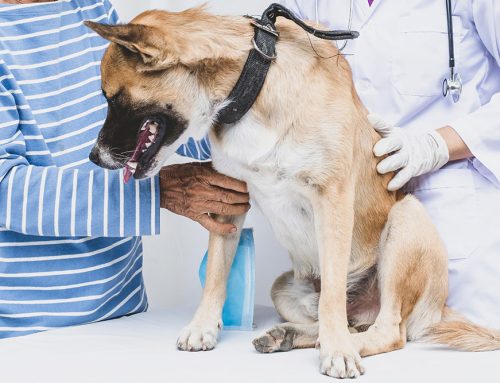Whether you’re new to caring for a pet or you’re a seasoned dog or cat owner, you’re likely aware of dental or periodontal disease in pets. Let’s break down this disease name’s meaning: Perio- relates to surrounding or supporting; whereas -dontal, refers to the teeth. Therefore, periodontal disease involves any problems associated with the teeth or their surrounding structures such as the gums (i.e., gingiva), hard palate, soft palate, or tongue). Periodontal disease is one of pets’ most common health issues, so our Adamson Veterinary Services team describes this condition. Your pet likely has periodontal disease if they exhibit one of the top 10 signs we explain here.
#1. Plaque or tartar on a pet’s tooth surfaces
Obvious plaque and tartar buildup on the teeth’s surfaces is a telltale sign your pet needs a dental checkup. These substances typically accumulate close to the gumline, with the canine, premolar, and molar teeth most commonly affected. If the film is light to yellow and somewhat thin, it is plaque, which is a sticky accumulation where bacteria proliferate. Dark, hardened material on the tooth surface is tartar, which occurs as plaque builds up and calcifies on the tooth.
#2. A pet has missing or loose teeth
With advanced dental disease, tartar buildup can lead to infection below the gumline, compromising the tooth root. When this happens, affected teeth become loose and may eventually fall out. You may not even know this is occurring because pets don’t often complain about dental problems. Most will just go about their day normally, without exhibiting pain or discomfort signs.
#3. Chipped, broken, or fractured teeth in a pet
Particularly voracious chewers commonly break teeth when they gnaw hard bones, toys, or other surfaces. This can result in tooth tip fractures or slab fractures in the large masticatory teeth. While tooth chips and fractures alone are not periodontal disease signs, they can hasten plaque and tartar buildup or infection because a tooth’s surface is compromised, which can lead to potential root pulp exposure.
#4. Foul breath in a pet
We all know doggy breath is real but this condition doesn’t necessarily mean your pooch has a dental problem. However, if the stench coming from your pet’s mouth smells rotten, putrid, or downright gag-inducing, then, “Houston, we have a problem.” Unless you brush your pet’s teeth twice daily, their breath likely won’t smell like daisies. However, a pet’s breath shouldn’t smell horribly unpleasant either. Foul breath could indicate your pet has a serious periodontal or other health problem.
#5. Red, angry, or bleeding gums in a pet
Gingivitis, gum tissue inflammation, is characterized by redness, and sometimes, the gums surrounding a pet’s teeth will thicken. Our Adamson Veterinary Services team often sees this secondary to plaque and tartar buildup under a pet’s gumline. This results in unnecessary pain, bleeding, and even infection if left untreated.
#6. Recessed gumline in a pet
Common with gingivitis, gingival recession occurs in many pets who have periodontal disease Gingival recession occurs when the gums surrounding a tooth lose their bony attachment and begin receding toward the tooth root. Plaque or tartar buildup and gingivitis can cause gum recession, which may eventually lead to tooth root exposure, infection, and other complications.
#7. Swelling or drainage on the cheek surface of a pet’s mouth
While pets hide dental disease behind their lips, tooth root abscesses can rear their ugly heads on the outer surface, causing swelling or even drainage from the cheek area. The classic tooth root infection signs (and likely underlying periodontal disease) are fluctuant swelling and/or pain just below the eye.
#8. An affected pet often has difficulty eating or retaining food in their mouth
Remarkably, many pets with severe dental disease manage to consume food normally, despite marked inflammation or even infection. However, because an affected pet’s mouth is painful, their chewing is abnormal and they chew exaggeratedly or food drops from their mouth while they are eating.
#9. A pet who is age 2 years or older can have dental disease
Did you know approximately 80% of dogs and cats older than age 2 have dental disease signs? Unless you diligently brush your pet’s teeth every day, use an antiseptic oral rinse, and/or other dental hygiene products, your pet likely has some level of oral disease by this young age.
#10. A pet with no history of receiving professional dental cleanings

If your pet is older than age 2 and hasn’t had a prophylactic dental cleaning, schedule their oral checkup with our veterinary team. We will start by performing a thorough examination of your pet’s mouth, recommending a tentative dental treatment plan. Depending on your pet’s age and oral health status, we may recommend a professional dental cleaning, dental X-rays, tooth extractions, or other therapies.
When in doubt regarding your pet’s dental care, your veterinarian is your best bet. Our Adamson Veterinary Services team is prepared to answer your questions about periodontal disease. Schedule your pet’s dental appointment and learn more about establishing their at-home dental care routine.







Leave A Comment